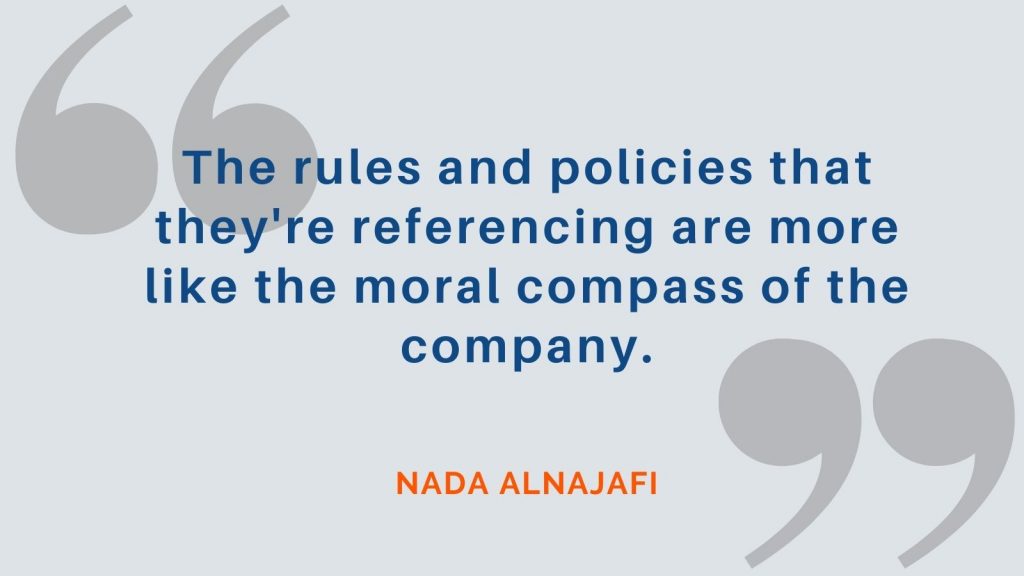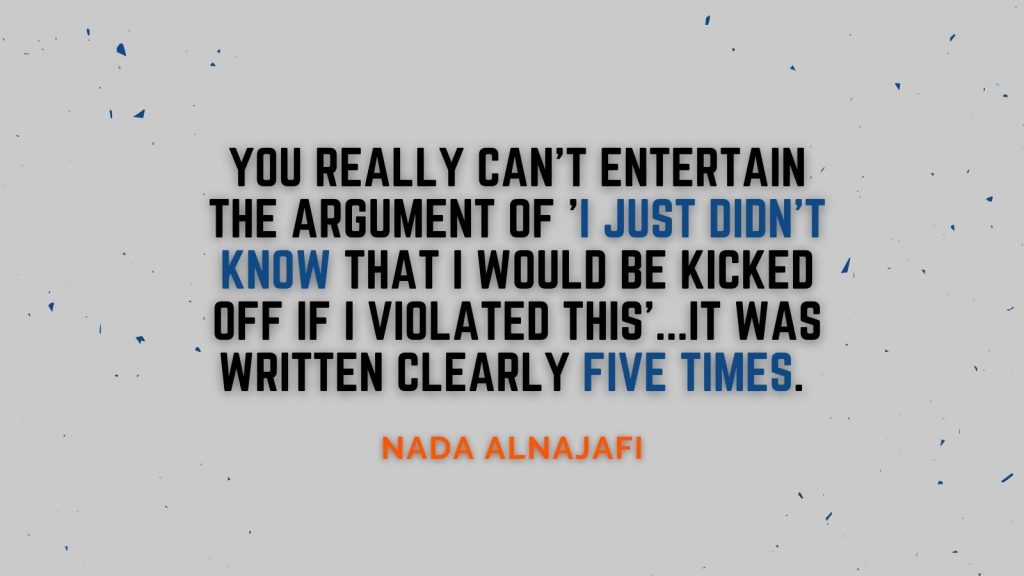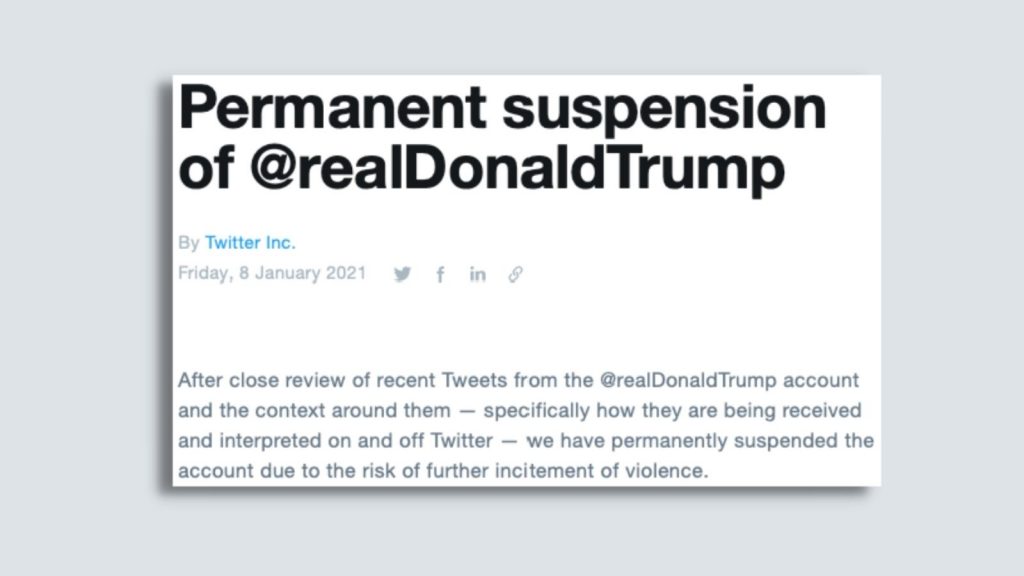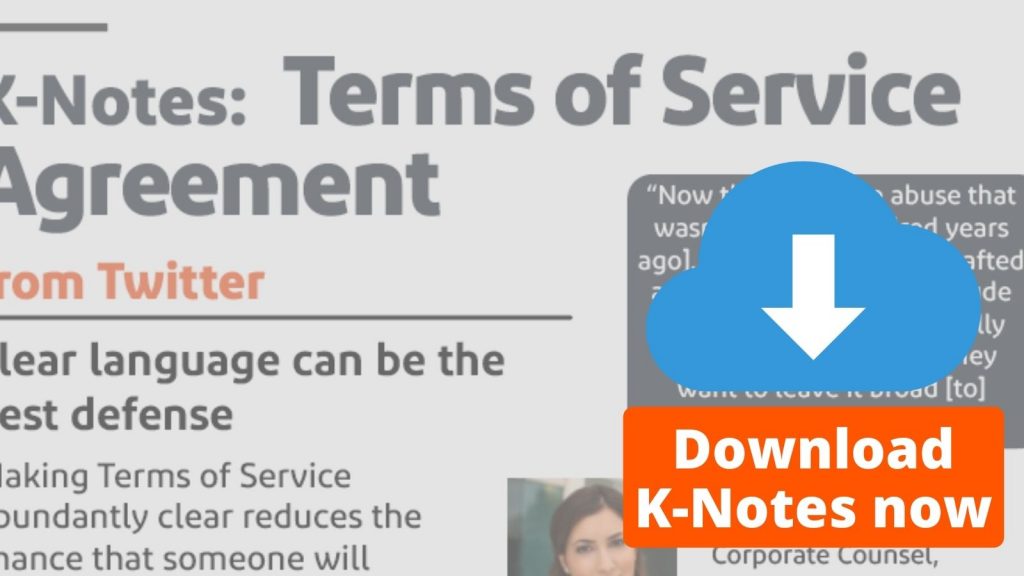How does Twitter’s Terms of Service Agreement give them the flexibility to operate and self-edit their platform of 330 million users? More than 20% of Americans use Twitter, and 189 countries have an official presence on Twitter. The contract between the users and Twitter that controls this avalanche of tweets is Twitter’s Terms of Service Agreement.
Nada Alnajafi, attorney and creator of Contract Nerds, tears down Twitter’s Terms of Service Agreement. With politicians and celebrities being suspended from Twitter, Alnajafi shows the strength of Twitter’s straightforward language in their Terms of Service Agreement and their accompanying Rules and Policies. These two documents give Twitter flexibility and control of its growing social media empire. Analjafi shows what Twitter did right in the Terms of Service Agreement and why you should use these ideas when you draft a similar document.
Questions:
- Why is it so important for Twitter’s TOS to have clear language?
- What are the effects of having a low, $100 liability limit?
- How does Twitter get people to read their Rules and Policies?
- Why was @RealDonaldTrump permanently suspended?
- Why don’t you get a notice when the terms are changed ?
The Difference Between TOS and Rules and Policies
Twitter’s Terms of Service tells you many times to review the Rules and Policies. Alnajafi explains that the Terms of Service is the legal agreement between Twitter and the user. But the Rules and Policies are where Twitter tells the world what user behavior they will or will not accept. It’s part of their culture and what they stand for as a company.

Twitter gave itself broad and subjective powers to decide what is or is not offensive or acceptable. They have the sole and final decision on what behavior will lead to temporary or permanent suspension from their platform. The Rules and Policies are on a separate URL to be easily updated and modified independently of any changes to the Terms of Service.
The Rules and Policies section of their website includes separate URLs for subjects like
- Twitter Rules
- Copyright Policies
- Report Violations
- Hateful Conduct Policy
- Abusive Behavior
- Government Guidelines
- Country Withheld Content
Clear Language May Be Your Best Defense
If someone makes a claim against a Terms of Service agreement, it’s often assumed they didn’t understand the agreement. Perhaps the language was confusing. In Twitter’s Terms of Service, the language is clear and easy to understand. Their Rules and Policies are even easier to understand with simple explanations. Making this language as clear as they can makes it less likely that a user will be able to claim they didn’t understand it.
!["Now there's online abuse that wasn't there [a hundred years ago]. If you crafted a definition that didn't include it, you might unintentionally exclude something. So they leave it broad enough [to] exercise their discretion." Nada Alnajafi](https://storage.googleapis.com/lawinsider-wordpress/1/2021/07/Now-theres-online-abuse-that-wasnt-1024x576.jpg)
Five Times’ the Charm
Twitter really wants you to read the Rules and Policies document. The TOS Agreement refers you to the Rules and Policies in five different places in the agreement and in five separate ways. If you violate these rules, you might be kicked off the platform temporarily or forever. Twitter users are everyday people from different cultures and countries, and with different languages, from around the world. Alnajafi says that is why drafting language is super important, as is knowing your audience.

Twitter knows that nobody, or almost nobody, really reads TOS agreements or Rules and Policies. Studies show that 91% of users agree to terms and service conditions without reading them. For younger users, ages 18-34, the rate is 97%. In an attempt to counteract this, Twitter drafted a six-section, easy-to-read agreement without too much legal jargon. They then ask you five times to review the Rules and Policies to know what action will get you suspended from Twitter. It works for most people – but not all.
The @realDonaldTrump Suspension In Legal Terms
Former President Donald Trump’s Twitter account, @realDonaldTrump, was permanently suspended by Twitter on January 8, 2021. The former President’s Twitter account was viewed by many as the most influential Twitter account with more than 88 million followers. Twitter shared their reasoning behind the actions with a post on their site.

Alnajafi explained the actions taken in terms of the legal and contract background and not the political ones. Twitter purposefully drafted their language to give them broad and sole power to suspend any user’s account. Twitter did not have to write a letter to the public explaining why they permanently suspended the account – but they did. Twitter decided that some of the former President’s tweets violated their Glorification of Violence Policy. The policy states in part, “You may not threaten violence against an individual or a group of people. We also prohibit the glorification of violence.”
When a Low Limit of Liability is The Right Call
Twitter wants the Limitation of Liability section to be conspicuous; it’s in all caps. Alnajafi points out that Twitter’s liability limit in this agreement is $100 or the amount the user paid Twitter for the past six months – whichever is less. Since Twitter is a free service, its liability is probably zero.
Alnajafi shows what Twitter did right in the Terms of Service Agreement and why you should use these ideas when you draft a similar document. #ContractTeardown Click To Tweet
Alnajafi agrees this is a surprisingly low cap on liability but says it was probably done to deal efficiently with the 350 million users in countries all over the globe. Twitter doesn’t want 350 million users suing them every time something goes wrong. It is up to the user to decide when signing up if they want free Twitter service, knowing their damages in a lawsuit are likely a maximum of $100.
Right to Change Terms at Anytime
Twitter may revise the Terms of Service at any time without giving notice to its users. Again, Alnajafi explains the cost, expense, and impracticality of sending notifications to 350 million people every time Twitter needs to make a change. The changes are not retroactive, and the current version is always posted on the Twitter Terms of Service page. When you use Twitter, you agree to the current Terms of Service, whether or not you were notified of any changes. Twitter says it will try to “notify you of material revisions” by email or service notification.
| 6. | General |
| We may revise these Terms from time to time. The changes will not be retroactive, and the most current version of the Terms, which will always be at twitter.com/tos, will govern our relationship with you. We will try to notify you of material revisions, for example via a service notification or an email to the email associated with your account. But continuing to access or use the Services after those revisions become effective, you agree to be bound by the revised Terms. |
Speaking to a Broad Audience
Twitter’s Terms of Service Agreement is the document that is used to control users’ actions and the content of 500 million posts per day. The agreement is neither long nor complicated yet works exceptionally well. Except for specific legal necessities, it is drafted primarily in everyday language.
Make it simple, broad, clear, and flexible: Twitter Terms of Service. #ContractTeardown. Click To Tweet
Normally, contracts are supposed to be as specific as possible. But, since Twitter founder Jack Dorsey sent the first tweet on March 21, 2006, Twitter traffic has grown to 500 million tweets each day. Twitter’s audience is so broad, the best way to craft a TOS agreement that fits this large audience is a four-pronged approach:
- Make it simple. Alnajafi says the language should be as free of “legalese” as possible.
- Make it broad. Twitter gave itself comprehensive powers of interpretation and the authority to have sole discretion in deciding to temporarily suspend or terminate a user’s account.
- Make it clear. Sole discretion may sound overly powerful, but Twitter goes out of its way to make it abundantly clear what kind of activity will fall under suspension.
- Make it flexible. To keep up with changing laws, customs, and cultural norms, Twitter can modify the Terms and Conditions at any time without prior approval or notification.
Twitter also has their Rules and Policies in simple everyday language at a separate URL, so they can be changed without redoing the Terms of Service. The Terms of Service Agreement acts as the contract between Twitter and its users. The Rules and Policies give the moral compass of what is or is not acceptable. So far, this combination seems to work very well.
Six Months After The Suspension
On May 5, 2021, The Desk of Donald J. Trump, @DJTDesk, was permanently suspended for violating Twitter’s ban on evasion. The account was apparently sharing posts from former President Trump’s website. Twitter said, “As stated in our ban evasion policy, we’ll take enforcement action on accounts whose apparent intent is to replace or promote content affiliated with a suspended account.”
With Twitter’s broad powers and sole discretion, if they want an account permanently suspended then it stays permanently suspended. More importantly, encoding the company’s moral compass into a document like Rules and Policies, (one that is more user friendly than a typical legal document), can help users understand how to not get suspended in the first place.
Show Notes
THE CONTRACT: Twitter’s Terms of Service Agreement
THE GUEST: Nada Alnajafi serves as Corporate Counsel for Franklin Templeton, and is the founder of ContractNerds.com. You can find her on LinkedIn.
THE HOST: Mike Whelan is the author of Lawyer Forward: Finding Your Place in the Future of Law and host of the Lawyer Forward community. Learn more about his work for attorneys at www.lawyerforward.com.
If you are interested in being a guest on Contract Teardown, please email us at community@lawinsider.com.
Transcript
Nada Alnajafi [00:00:00] I think what’s important is to me, your language is clear to the user. One of the defenses to violating a contract could be, well, I didn’t understand it in the first place or I didn’t know that that’s what that meant by that. So if you can automatically counter that with. But it was written so clearly. So you really can’t entertain the argument of I just I didn’t know that I would be kicked off if I violated.
Intro Voice [00:00:29] Welcome to the Contract Teardown show from Law Insider, where legal experts tear down contracts from some of the most well-known companies and high profile executives around the world.
Mike Whelan [00:00:41] In this episode, Nada Alnajafi, lawyer and creator of Contract Nerds, tears down the Twitter terms of service. This document has been in the news a lot lately, with politicians and celebrities removed from the platform for violating its rules. Drafting a terms of service document that gives a platform like Twitter. The flexibility to operate and self edit is no easy task, and Nada shares important principles for threading that needle. So let’s tear it down.
Mike Whelan [00:01:11] Hey, everybody, welcome back to the Contract Teardown Show. I’m Mike Whelen. On this show we do exactly what the name implies. We take contracts and beat them up with rage and fear. I bring on smart friends like Nada Alnajafi, who is here to talk to us about a hot topic, and we’re going to try not to get in trouble. Nada, how are you today?
Nada Alnajafi [00:01:35] I’m good, Mike. How are you?
Mike Whelan [00:01:37] I’m OK. I’m feeling a little OK. This is OK. It’s not our fault, OK, that before any of you start writing us emails and text messages and comments below, I didn’t create this situation. We’re just talking about a contract. Relax. The contract that we’re talking about is this one the Twitter terms of service. And specifically, we’re going to dig into how someone who I don’t know might be president could get kicked off of Twitter according to their terms of service. So we’re going to roll through this thing, Nada. Why are we talking about this? What is in this moment, but also as contract drafters, why is it terms of service, a useful document to talk about for the companies that we represent?
Nada Alnajafi [00:02:24] Great question. Well, every single website anyone uses usually has a terms of use, and it is simply a contract between the website provider, which here is Twitter and the user. And Twitter has last time I checked, about three hundred and thirty million users. So this agreement applies to all three hundred and thirty million of them. So I think it’s little important to check out what’s actually in the terms of use.
Mike Whelan [00:02:54] Yes. And I I’m talking to you about this. I want to know what I tell the viewers a bit about yourself, about your background and how you’re coming at this terms of service document.
Nada Alnajafi [00:03:07] Yes, so I have been an in-house attorney for about 12 years now, I’m currently in-house at Franklin Templeton, but nothing I say on this video is ever representative of Franklin Templeton’s opinion. It is simply my opinion, as Nada Alnajafi. Just want to make that clear. And I love contracts. I love negotiating contracts and dissecting them. And I really love your show, Mike. And I figured this would be a great contract to talk about, given all the chatter in the news recently.
Mike Whelan [00:03:43] The hullabaloo, lots of opinions on both constitutions and contracts out in the world. We’re going to try to avoid most of that drama. And first, talk by start by talking a bit about the technicalities of this document. So, Nada, if you’ll go with me, I’m going to roll down to Section five on this document called The Disclaimers and Limitations of Liability. There’s talk about the services being as is. It makes no warranties. But then down in the limitation of liability, there’s that famous all caps section. It says basically nothing is our fault. And specifically, it says in no event shall the aggregate liability of the Twitter entities exceed the greater of 100 U.S. dollars or the amount you paid Twitter, which is zero. Talk to me about that section, about this cap liabilities. Is this going to work?
Nada Alnajafi [00:04:35] Yeah, so they basically want to completely limit their liability in terms of the types of courses of action that users can sue them for in civil court, why? Because they don’t want three hundred and thirty million users suing them in court every time they get unhappy about something. Now, when we look at the limitation of liability language, the stuff in all caps, that’s pretty standard. But when we get to the limitation of liability cap, which is one hundred dollars, that to an attorney who sees a lot of contracts, could kind of take one back and you could kind of think, wow, that is really low. But we do have to remember here that Twitter is offering this service for free. So when it comes down to it, it’s really up to you as a user to decide do I want to use Twitter and take on this risk that I will not be able to sue them in court if I’m unhappy. And if I do, the maximum ever going to get is one hundred dollars. That’s something to think about.
Mike Whelan [00:05:37] Yeah. And I you know, it’s got the word here in in there. So, you know, it’s legally I’m down to six now to this general section. It talks about, you know, any time you’ve got these terms of service, these things change. Right? We get these emails, none of us read them. We’re just hitting delete. My wife always makes fun of me because I don’t read documents that are put in front of me. And I always say their lawyers are better than mine. But under general, it says we may revise these terms from time to time. The changes will not be retroactive. The most current version of the terms will be on the website will send you an email. Talk to me about does this cover their requirements in terms of letting people know what the changes are?
Nada Alnajafi [00:06:19] Yeah, absolutely. And, you know, most people probably don’t review the terms of use of these websites until they’re upset about something. Something didn’t go their way. And then they scroll through and they’re like, what? They can make a change any time they want. But the reality is, again, three hundred and thirty million users, they can’t send out notifications every single time they want to update their terms of use. That would be, from a practical standpoint, really difficult and expensive to manage. So they say they reserve the right to make changes at any time. They will try to provide notice. If there is a significant or material change, that’s sometimes you’ll get an email saying Twitter has now updated their terms of use. That may happen once a year or so. But in general, they like to keep up with the laws that are changing, whether it’s a privacy law or some other type of standard that they want to go ahead and make that update on the website.
Mike Whelan [00:07:14] Hey, everybody, I’m Mike Whelen, I hope you’re enjoying this episode of the Contract Teardown Show real quick. I want to ask you to do me/you really a quick favor. Look down below. You’ll see a discount code to join the law insider premium subscription. When you do that, you get access to more content like this. You’ll see webinars, daily tips on contract drafting, not to mention access to the world’s largest database of sample contracts and clauses. It will help you write better contracts faster if you want to do it. Right now, there’s a code below. So get there. Also, if you’re part of a larger team, if you’re in-house or in a law firm, just email us. We’re at sales@lawinsider.com. We’ll make sure you get a deal as well. Come join us in the community. The code is below. Let’s get back to the show.
Mike Whelan [00:07:59] Well, now that we’ve covered sort of the safe stuff, let’s jump to the drama. I want to point out on this document whether you’re talking about the content or canceling. There’s this phrase that comes up multiple times. So let me point it out under three under content and services. It talks about we can reserve we reserve the right to remove content that violates the user agreement. And it says go down and look at the rules. And the policy is if you look again down further down in four, please review the Twitter rules and policies. This is how you have to use this thing. We may also remove or refuse to distribute any content on the service if it violates these Twitter rules and policies. You keep going under the the ending of the terms don’t violate the rules and policies. So what we know is in this document, there’s a bunch of references to another document. Tell me as we shift to the news newsiness of the moment, why is that relevant? Why is pointing over to this other document outside this one relevant?
Nada Alnajafi [00:09:06] So the terms of use itself is more like the legal terms and conditions. The rules and policies that they’re referencing to is more like the moral compass of the company. What does Twitter want to be known for in terms of their beliefs, their branding? What do they stand for as a company? What will they accept? What will they not accept in terms of behavior and conduct? And some of these concepts are more left to the subjective mind, like does it feel wrong? Does it feel that it is offensive? And that’s where Twitter points to the rules and policies, which is on a separate URL so that they can always update that and modify it from time to time. And if you violate one of these rules and policies, which they Twitter has pretty broad discretion to decide on, then you violate the terms of use and therefore you can be permanently suspended.
Mike Whelan [00:10:01] Right. And we’ll talk structurally about the relationship between those documents at the end when we try to address the principles, because we’re really trying to help attorneys who are having to draft this kind of thing. But I do want to address sort of the the the what do they say? The monkey, the elephant in the room, the elephant in the room. The guy might have a monkey with them, but it’s this document. It is a letter that Twitter issued about the permanent suspension, suspension of the account at real Donald Trump and what they talk about in the beginning, going back to the the rules of, you know, that moral code that you talked about for Twitter. They said after close review of recent tweets from that account and the context around them, specifically how they are being received and interpreted on and off Twitter, which is interesting, we have permanently suspended the account due to the risk of further incitement of violence. And if you go to their policies that they reference, they actually send a link over to this document, this glorification of violence policy. It says you can’t threaten violence, but you also can’t glorify violence. There’s not a lot of specificity in this. I mean, there are a lot of words, right? There’s about protected classes. But talk to me about how Twitter used this moral code to make a decision about what was a very politically heated question.
Nada Alnajafi [00:11:25] Well, that’s a good question, I don’t know how Twitter, you know, landed on using this specific policy to cite as the reason that they permanently suspended Donald Trump. But from the way it’s drafted, it looks like the drafter purposefully brought it, purposefully drafted the language to be broad so that there was room for a subjective interpretation, No. One, so that Twitter has sole discretion at the end of the day, whether someone can be a user on their platform or not. And that’s from a legal and business standpoint within their right to do so, but also because these are very difficult concepts to define kind of in a static way. They are dynamic. The ways that you can abuse someone has changed from one hundred years ago to now. Now there’s online abuse there wasn’t that before. If you were to have crafted a definition that didn’t include it, you might unintentionally exclude something. So they want to leave it broad enough so that they can exercise their discretion. But what Twitter did here was they wrote a letter to the public stating why they made that decision and they decided to post in particular that they believe violated the glorification of violence policy, which they didn’t have to do. They didn’t owe a duty to do that per their terms and conditions, but they did that voluntarily.
Mike Whelan [00:12:49] Yeah. And I think this is an interesting example because, A, it’s just drawing interest right now for obvious reasons, but B, because you see the business use case. Right. And for a lot of attorneys that are drafting these kinds of documents, we talked about this with Colin Levy with Boston.coms, terms of service. In a similar vein, there’s there’s not a lot of control that these companies have over the content that’s put on these sites. And so they seem to sort of have this policy of we’re going to create the ability to clamp down, but not the requirement to clamp down. And my sense is and correct me if I’m wrong by doing these sort of two separate documents, one, that’s this terms of service. Here’s what what we’re required to do. And over here, the rules, this moral code that that seems to create the sort of semi-permeable wall. Right. That they can like. I’m just thinking structurally, what’s the structural advantage of putting it in two separate documents as opposed to one? Is there one?
Nada Alnajafi [00:13:51] That’s a really good question. The terms of use, you really you want to try to keep it focused on the legal duties and liabilities versus the rules and policies is more around company culture, branding. And, you know, the moral compass that we talked about, each one has its own way of being dynamic and should and can be updated from time to time. I think a lot of it was due to organizational reasons keeping them separate, but also from the user standpoint so the user can understand, hey, maybe I don’t understand or want to read these long legal terms, but I do want to know what I can and can’t do from a practical standpoint so I can go over here to this link instead.
Mike Whelan [00:14:38] Yeah, I’m noticing fewer here ends and heretofore is in there in such and such as in in the moral code. But it is an interesting thing because you saw with Twitter, obviously, before they pulled President Trump’s account, there were a lot of calls to poll President Trump’s account well before this moment, and they never felt an obligation to do it. So to me, this we’re not making a judgment yet and I are not making a judgment about whether this is right or or moral or even ethical or good for society. It’s just a question of can the business do this and how can they do this? And so I wanted to ask you in terms of if I’m the drafting attorney, if I’m somebody who’s having to give what I’m seeing here is that the business wants flexibility and also strength. What are some principles that I can pull from this experience, these documents? Do you think Twitter did this well? Is there some, you know, lesson that a lawyer can pull from this experience that can tell them, here’s how I need to do this? Well, any any principles you draw from this?
Nada Alnajafi [00:15:42] I think what’s important is to make your language clear to the user, so however many, however much you can reduce the hearings and the whatsoever, that’s going to be helpful because one of the arguments that would be difficult to. Let me say that again, one of the defenses to violating a contract could be, well, I didn’t understand it in the first place or I didn’t know that that’s what that meant by that. So if you can automatically counter that with. But it was written so clearly we gave an example. We said it five different times. If you read the Twitter terms of use, they reference their rules and policies five different times and they say in five different ways. If you violate the rules and policies, you will no longer be able to be a user. So you really can’t entertain the argument of I just I didn’t know that I would be kicked off if I violated this. So that’s I think clarity in the drafting language is super important and know who your audience is. They are everyday users from all around the world coming from different cultures. They speak different languages. So make it as clear and concise as possible.
Mike Whelan [00:17:02] It’s an interesting thing, though, structurally, because I’m thinking about it as a way to accomplish this. Right. Like you as the lawyer, you have to have these legal checkboxes and you’ve got to have the language in there that that keeps people out of trouble. Obviously, that’s your job. But you’re also trying to communicate something. You’re doing a social nudge to use a Cass Sunstein ism. You’re trying to nudge people into certain behaviors. What’s interesting that I found about this when I signed up for Twitter, at least when I signed up for it forever ago, I’m at Mike Whelen Jr. You guys can find me. I therapize out loud there. But when I signed up for it, as I recall, its links. Right. So they give you the terms of service. They give you this very long legally document, and then you’re supposed to click a link to go over to the public targeted, you know, normal speak rules. I guess my sense is, if you’re going to do this, maybe this is a principle, maybe this isn’t. If you’re going to do this and you’re going to say this is the jargon free, clear guide for how to act like an adult on our space, then put that in front of people, make them agree to it separately. You know, make sure that it’s not a link that somebody has to actively go push to go somewhere else. You know, I don’t know how you feel about that, but I just I feel like for me personally, I’m just going to scroll through the legalese.
Nada Alnajafi [00:18:19] Yeah. So you want it all right in front of you? I agree. I think that would be helpful. But also, in general, your terms and conditions should be free of legalese to the extent possible. Of course, there’s a traditional language that we have to keep in. Like some things around limitation of liability or indemnification need to be raised a certain archaic way for it to be interpreted the way we want it to by the courts. But otherwise, you’re speaking to users, to regular everyday people. So even your terms and conditions should be very simple to digest. And if what you’re saying, what you’re saying is bring also the rules and policies in front of me and maybe create a checkbox for those, too, not a bad idea.
Mike Whelan [00:19:01] Hmm. Well, watch this space, everybody. Twitter just announced yesterday we are recording this in January of twenty twenty one, the year, I think twenty twenty just sort of has spilled over. But we are officially in January twenty twenty one. And Twitter just announced yesterday that they’ve got this new program, this I think they call it Birdwatch, where other users can go in and score things that people have said for truthiness. If you’ll notice, that sounds an awful lot like Parlor’s approach, which was a total disaster and didn’t work at all. So all these companies are trying to figure this out, I’m assuming. I don’t know if there’s any legal strength to this, but I’m assuming maybe if they want to say, well, we acted fairly, maybe the public statements of all those people saying this looks like nonsense. And here’s the proof of it is useful to them, I don’t know, moving area. I hope you guys will pay attention to that. In the meantime, if people want to get in touch with you, to follow you on the social spaces where you put all the appropriate disclaimers and say all the smart things, what’s the best way to connect with you?
Nada Alnajafi [00:20:04] Yeah, I’d love it if you connected with me on LinkedIn, Nada Alnajafi, and you can also follow me at contractnerds.com along on the on the blog or on the contract nerd’s LinkedIn page.
Mike Whelan [00:20:16] Oh, I should show host privilege. I should ask you, what is contract nerds anyway. What are you up to on there. I want to make sure people can find that if they’re interested, if they are in fact contract nerds, which if you’re still watching you qualify,
Nada Alnajafi [00:20:29] you probably are. Yes. Well, Contract Nerds is the new home for everything contracts. It’s a blog and a community. And we publish a weekly blog post every Wednesday straight to your inbox if you’re a subscriber, all about contracts, contract management, contract negotiation, anything to do with contracts that a contract nerd would love is on the contract nerds website. So you can go to www.contractnerds.com, thank you for that.
Mike Whelan [00:20:57] Absolutely. And we’ll make sure that that stuff gets linked in the show notes you guys can access the show notes at lawinsider.com/resources. And if you want to be a guest like Nada, where we can pick on contracts all you have to do is email us. We’re at community@lawinsider.com. Thank you, Nada. We will see you guys on the next Teardown.



!["Terms of Use you want to keep focused on the legal duties and liabilities. The rules and policies are [centered] around company culture and branding."](https://storage.googleapis.com/lawinsider-wordpress/1/2021/07/Terms-of-Use-you-want-to-keep-focused-on-1024x576.jpg)
